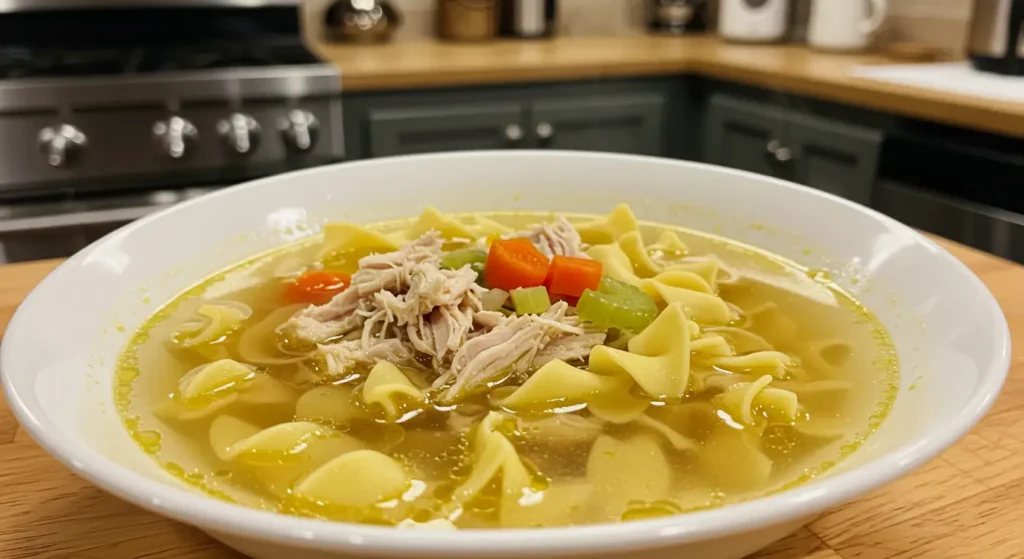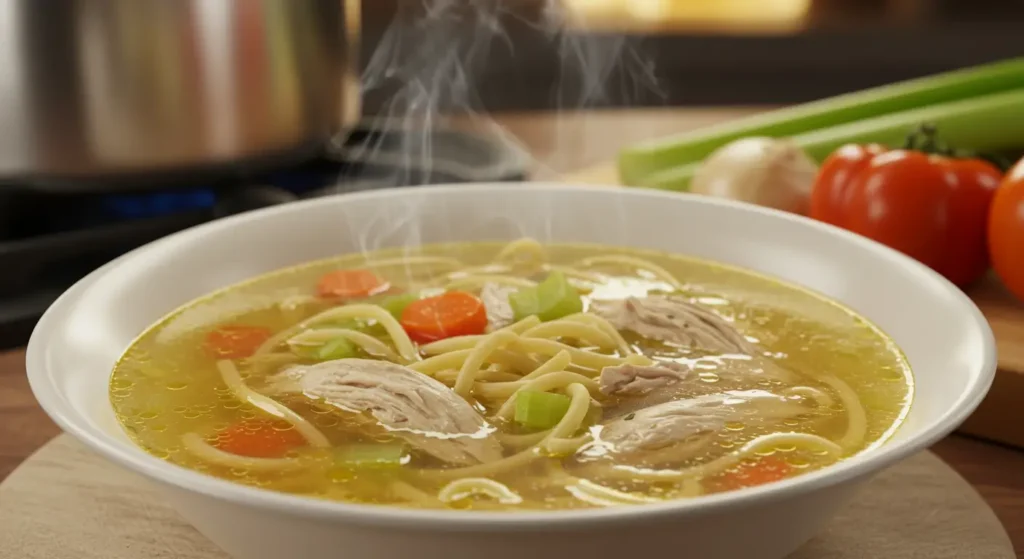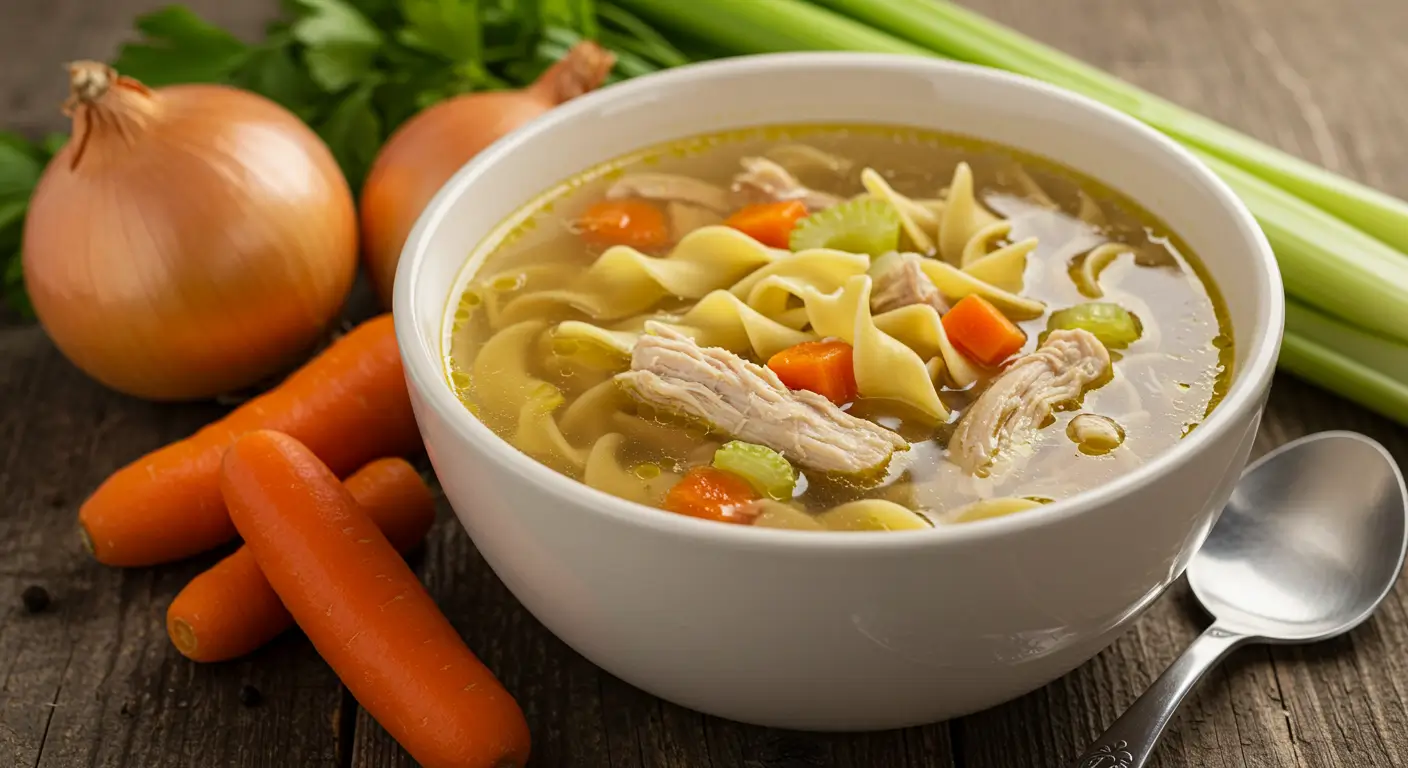Ever wondered why your meatloaf is dry while others are juicy? The secret is simple. It’s about a few key tips that make your homemade chicken noodle soup a hit. This guide will show you how to make a classic chicken noodle soup that’s perfect for any cold day.
Learn to use top-notch ingredients and cooking methods. You’ll make a delicious homemade chicken noodle soup that’s not just good for you but also warms your heart. You’ll find out how to pick the best chicken and spices for that perfect flavor.
Table of Contents
Understanding the Basics of Chicken Noodle Soup
To make the best chicken noodle soup, you need to know the key ingredients. These include chicken, broth, noodles, and vegetables. Choosing the right ingredients can make your soup truly special.
What Ingredients Matter Most?
Some ingredients are more important than others for a flavorful soup. A fresh or leftover rotisserie chicken adds a lot of flavor. Chicken or vegetable broth is great for the base.
For noodles, egg noodles are classic, but rotini or fusilli can also be good. Carrots, celery, and onions add texture and taste.
Choosing the Right Chicken
The type of chicken you use affects the soup’s taste. Chicken thighs, about 4 to 5 pieces, are juicy and flavorful. Using a rotisserie chicken saves time and is cost-effective.
Flavoring Your Soup
Adding fresh herbs and aromatics boosts the flavor. Basil, oregano, garlic, and onion are great starting points. Spices like bay leaves and rosemary add depth to the broth.

The Importance of Moisture
Moisture is key to a comforting bowl of chicken noodle soup. It keeps the chicken moist and the broth rich. This makes the soup flavorful and textured.
Why Moisture is Key
Moisture is vital for a great soup. Start with 8 cups of chicken broth, homemade or high-quality store-bought. Use diced chicken, like bone-in thighs, for depth and flavor.
Sautéing vegetables in butter for 5-7 minutes adds moisture. This captures flavors that mix well in the broth.
Adding Juiciness to Your Soup
Adding noodles at the right time is important. Cook egg noodles for 6-8 minutes. For a thicker soup, add 2 tablespoons of flour during sautéing.
This makes the soup velvety without losing the chicken’s juiciness. Optional spices like red pepper flakes add heat, making each spoonful flavorful.

| Ingredient | Quantity | Contribution |
|---|---|---|
| Diced Chicken | 1 lb | Moisture and flavor |
| Carrots | 1 medium (or 3 sliced) | Sweetness and texture |
| Onion | 1 | Flavor enhancement |
| Celery | 1 stalk | Crunch and taste |
| Butter | 3 tablespoons | Base for sautéing |
| Flour | 2 tablespoons (optional) | Thickening agent |
| Chicken Broth | 8 cups | Rich base |
| Egg Noodles | 4 ounces | Bulk and texture |
Essential Ingredients for Chicken Noodle Soup
Making a delicious bowl of chicken noodle soup starts with the ingredients. Choosing between homemade and store-bought noodles affects the taste and texture. Adding colorful vegetables boosts both flavor and health.
Homemade vs. Store-Bought Noodles
Homemade egg noodles are a clear winner. They offer a unique texture and flavor that store-bought noodles can’t match. While making noodles at home takes more time, it’s worth it for a better taste experience. Opt for extra-wide egg noodles for the best results.
Including Vegetables for Nutrition
Vegetables are key to a nutritious chicken noodle soup. Chopped carrots, celery, and onions add color and important nutrients. Onions bring sweetness, while celery adds crunch. Fresh herbs like parsley or thyme enhance flavor and health benefits. Aim for at least two cups of vegetables in your soup.
The Role of Cooking Techniques
The way you cook your chicken noodle soup greatly affects its taste and texture. Learning to sauté veggies and cook your soup right is key. It helps create a rich flavor, whether it’s a classic or quick soup.
Sautéing Vegetables for Flavor
When you sauté veggies in olive oil or butter, their sweetness comes out. Onions should cook for 4 to 5 minutes until they’re soft and clear. Carrots and celery add great flavor to the broth, making your soup hard to resist.
This step sets the stage for a flavorful soup. It’s the first step before adding the chicken and broth.
Simmering vs. Boiling
After adding everything, simmering is the best choice. It lets the chicken, veggies, and seasonings blend well, keeping moisture in. Aim for 25 to 30 minutes of simmering.
This patience is worth it. It makes the chicken tender and the broth rich. Boiling can dry out your food. So, using the right cooking method is key for a comforting soup.
Seasoning for Delectable Flavor
Seasoning is key to making your chicken noodle soup stand out. Salt is essential for bringing out all the flavors. It’s important to season as you go, not just at the end.
This way, you get a balanced taste that makes your soup unforgettable.
Using Salt Properly
When using salt, be precise. Start with 1 teaspoon of salt early on and adjust as needed. Remember, other ingredients like broth and Parmesan also add saltiness.
Taste before serving to see if you need more salt. Adding salt gradually helps avoid an overly salty taste. This lets the flavors of carrots, celery, and chicken come through.
Spice Blends to Experiment With
Spice blends can deepen your chicken noodle soup’s flavor. Try adding fresh herbs like thyme, parsley, and sage for extra taste. A bit of red pepper chili flakes adds heat, while black pepper adds a nice finish.
Here are some spice blend ideas:
| Spice Blend | Description | Flavor Notes |
|---|---|---|
| Italian Seasoning | Mix of herbs like oregano, basil, and rosemary | Earthy and aromatic |
| Herbes de Provence | Combination of dried herbs including lavender and thyme | Floral and fragrant |
| Garlic Powder | Dehydrated garlic for a concentrated punch | Robust and savory |
| Curry Powder | Blend of spices that adds warmth | Complex and exotic |
Each blend gives a unique twist to the classic chicken noodle soup. You can adjust the spices to your liking, making your dish truly special. With careful seasoning, you’ll make a soup that warms the heart and satisfies the soul.
Cooking Temperature and Timing
Knowing the right temperature and timing is key for your homemade chicken noodle soup. Cooking at the perfect range makes the broth rich and the chicken tender. This guide will help you master the temperature and timing for a delicious soup.
Optimal Cooking Range
For the best taste, aim for a gentle simmer at 190°F to 200°F. This temperature extracts flavors without overcooking. Simmer the chicken in broth for 25 to 30 minutes. This makes the meat tender and adds flavor to the soup.
Keeping an eye on the temperature ensures your soup stays moist.
Timing for Different Ingredients
Timing is important for each part of your soup. Start by cooking the vegetables like onions, carrots, and celery until they’re translucent. Then, cook the chicken for 3 to 4 minutes on each side before adding it to the broth.
The noodles need 8 to 10 minutes to cook. This completes the mix of textures and flavors in your soup.
Using a Chicken Thermometer
Cooking chicken right is key for safety and taste. A chicken thermometer ensures your meat hits 165°F. This makes the chicken safe and juicy, ideal for your soup.
Knowing how to check this temperature is vital. It greatly improves your cooking.
Ensuring Safety with Temperature
Measuring chicken temperature is very important. Undercooked poultry causes 25% of foodborne illnesses. About 80% of home cooks use thermometers to avoid this.
For safe cooking, aim for 20 to 30 minutes. Use medium to medium-high heat on the stovetop for up to 25 minutes. Pressure cookers like Instant Pots work best with 15 minutes of cooking and a 10-minute natural release.
Perfect Temperature for Chicken
Reaching 165°F makes your chicken safe and keeps it moist. A digital thermometer is the most accurate choice for 70% of cooks. After cooking, let the chicken rest for 5 to 10 minutes.
This step helps the juices spread, making the chicken more flavorful. Properly cooked chicken adds depth to your soup.
Enhancing with Glaze and Toppings
Adding toppings and garnishes can make your chicken noodle soup even better. The soup already tastes great, but a few extra touches can make it unforgettable. These additions bring out more flavor and freshness, making every bowl special.
Classic Add-Ons for Extra Flavor
Fresh parsley adds color and a bit of brightness. A drizzle of olive oil brings richness and savory taste. Lemon zest and juice add freshness, contrasting the broth’s richness. Try these classic add-ons:
- Fresh parsley for garnish
- Drizzle of olive oil for richness
- Lemon zest and juice for brightness
- Freshly cracked black pepper for a hint of spice
Creative Garnishes to Try
For a more adventurous soup, try new garnishes. Crispy fried onions or croutons add crunch. Smoked paprika or hot sauce can add exciting flavors. These touches can turn your soup into a gourmet dish.
- Crispy fried onions for crunch
- Croutons for added texture
- Smoked paprika for a smoky flavor
- Hot sauce for an extra kick
Choosing the right toppings not only boosts flavor but also makes the meal look good. Mixing classic and unique elements will give you the best chicken noodle soup. It keeps comfort food at its core.
Serving Your Chicken Noodle Soup
When it’s time to serve your delicious chicken noodle soup, make it inviting. The right serving style can make everyone at the table happy.
Perfect Serving Suggestions
Choose large, deep bowls to show off the soup. Serve it hot, at 165º F, for the best flavor. Add fresh herbs like parsley or thyme for color and freshness.
Accompaniments to Consider
Pair your soup with crusty bread or warm biscuits. These sides go well with the broth. A side salad adds a refreshing touch. These meals bring warmth and coziness to any gathering.
Storing and Reheating Techniques
After making a tasty batch of homemade chicken noodle soup, it’s key to know how to store and reheat it. This keeps the flavor and texture just right. Here are some tips to keep your soup fresh for later.
Best Practices for Storage
For safe storage, use airtight containers to keep air out. Put the soup in the fridge for up to 5 days. For longer, freeze it. Leave some space at the top for liquid to expand.
Smaller portions cool faster and reheat better. They’re also easier to manage.
Reheating Without Losing Flavor
Reheating your leftover soup needs care to keep flavors and textures good. Don’t microwave big batches. Heat small amounts in a saucepan over medium heat, stirring now and then.
This method heats evenly and saves your ingredients. If frozen, thaw it in the fridge first. This way, noodles stay firm and broth stays rich. Always mark containers with the date for freshness.
Exploring Variations on the Classic Recipe
Chicken noodle soup is a favorite dish that lets you get creative in the kitchen. You can try many different versions that keep the comforting feel. Making your simple chicken noodle soup your own can meet different tastes and needs.
Inspired Twists to Try
Here are some creative ideas to make your chicken noodle soup better:
- Add chopped kale or spinach for a nutrient boost.
- Incorporate butternut squash for a hint of sweetness and texture.
- Use whole grain or gluten-free noodles to accommodate special diets.
- Introduce spicy elements by adding cayenne pepper or red pepper flakes.
Healthy Alternatives for Soup Lovers
It’s easy to make your chicken noodle soup healthier while keeping it cozy. Try these options:
- Use skinless chicken breasts instead of thighs to reduce fat content.
- Opt for low-sodium chicken broth, helping to manage sodium intake.
- Include a variety of vegetables like bell peppers, green beans, or zucchini.
- Swap heavy cream for a splash of lemon juice for a brighter flavor.
These changes turn your basic soup into a colorful and nutritious meal. They show that a healthy chicken noodle soup can be tasty and appealing.
Final Thoughts on Homemade Chicken Noodle Soup
Making your own chicken noodle soup lets you control the flavors and ingredients. This means you can make it just the way you like it. Homemade soup is fresher and healthier, using top-quality ingredients like fresh herbs and low-sodium broth.
It also tastes better and is more nutritious. With an average rating of 4.80 from 150 votes, many people love this recipe’s taste.
Why You Should Make It Yourself
Making the best chicken noodle soup from scratch is incredibly rewarding. You can make six generous servings in about 30 minutes. This saves money compared to buying pre-made soup.
Adding fresh veggies and homemade noodles makes it healthier. You can also adjust the seasoning or add lemon juice for a zesty twist.
The Comfort of a Classic Recipe
Soups are all about comfort, and this recipe is no exception. It warms both your body and soul. Each bowl is a symbol of care and warmth, perfect for sharing with loved ones.
You can try different herbs or veggies while knowing you’re serving a nutritious meal. Every spoonful is not just delicious but also good for you.
FAQ
What gives homemade chicken soup more flavor?
To enhance the flavor of homemade chicken soup, try adding aromatic vegetables like onions, carrots, and celery. Herbs like thyme, bay leaves, and parsley bring depth, while garlic, ginger, and lemon juice add brightness. Simmering the chicken with the bones helps extract more flavor, creating a rich, savory broth.
What are the ingredients for chicken noodle soup?
The basic ingredients for chicken noodle soup include chicken (usually chicken breast or thighs), carrots, celery, onions, garlic, chicken broth (or water), and egg noodles. Seasonings like salt, pepper, bay leaves, and thyme are added for flavor.
What do you put in homemade chicken soup?
In homemade chicken soup, you can include ingredients like chicken, carrots, celery, onions, garlic, herbs (such as thyme and parsley), and broth. You can also add noodles, rice, or potatoes for texture, depending on your preference. Lemon juice or vinegar can be added at the end for a tangy finish.
What can I add to my chicken noodle soup to give it flavor?
To give your chicken noodle soup more flavor, try adding fresh herbs like rosemary or thyme, garlic, ginger, and lemon juice. A touch of soy sauce, hot sauce, or parmesan cheese can also elevate the broth. Adding mirepoix (a mix of onions, carrots, and celery) and bay leaves during the simmering process can deepen the flavor.

